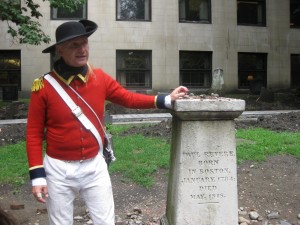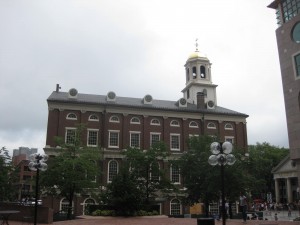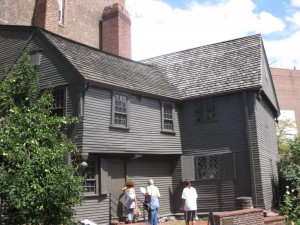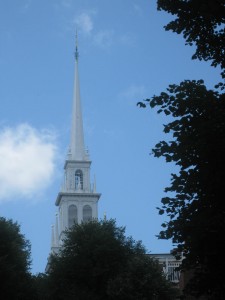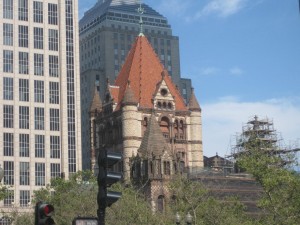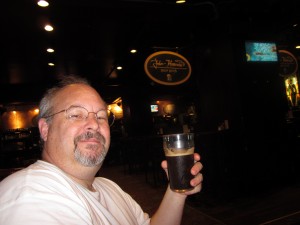This time, the pillows were great, but the mattress was lumpy. I’m not finding a lot of joy in these East Coast hotels so far. Are my expectations too high? At least there was a breakfast and it was good.
We made our way to the terminal, found parking on the roof, then descended down the long escalator. What was neat about the escalator was that each floor had its own escalator, side by side with the other escalators. The third floor’s escalator was one flight up (from the second floor), the forth was two flights up, and our fifth floor was three flights up. It looked like art.
Getting our day passes was a breeze, and we were soon on our way. The train dropped us off at Boston Common, the big park in the middle of the city where our tour would begin.
We found (temporary) bathrooms, and then we found our guide, a history teacher who did these Freedom Trail walks on the side. Today, he was dressed in a Redcoat outfit. I am so glad that we got a historian rather than an actor. Sure, the actor would have been more lively, but the historian was more accurate, and as it turned out, he had a wicked dry sense of humor.
We learned about various men, some of the original buildings, but mostly about the misinformation that can be found in our history texts:
- We did not win the war because the Redcoats wore red coats and we employed guerrilla tactics. Both armies used standard “linear” battle techniques, and we lost almost every battle because the British were so much better trained. We only won because we never quit and the British got tired of this. Also, we used Dutch money to finance the war, and most important, we used French ships to blockade every American port. Without that, the British would have sent wave after wave of infantry and we would have lost. Oh ya, all of Europe was fighting at that time as well, so “our” war was seen as secondary. Eventually, the British asked us to split with them at the treaty of Paris.
- George Washington only won three battles the entire war, and only due to special circumstances (He attacked German mercenaries on Christmas – Crossing the Delaware, He surprised an outpost while they were sleeping – Valley Forge, and in his most famous victory, half the opposing troops were conscripted French who were allies with the Americans – Yorktown).
- Paul Revere would never had said “The British are coming, the British are coming,” since he and everyone else considered themselves British at the time. He would have said: “The regulars are coming, the regulars are coming!”
- It was a bunch of rabble rousers who dressed unconvincingly as Indians who did the whole Tea Party thing. The truth is that the tea tax was so small that it didn’t bother anyone, and the tax was placed on the Americans five years after it had been placed on the British subjects, and at one tenth the amount. The colonists would have had to drink a gallon of tea a day for a year before they would have been charged the eighty cent tax. The amount of tea they threw overboard would amount to 1.3 million dollars today.
- “Taxation without representation” would never have been uttered. The colonists were the wealthiest people in the world at that time, yet they were paying almost no taxes. Also, if America got representation in the British Parliament, they would have had only eight seats, and their votes would have been defeated every time. Also, IF they got representation, they would then be adhering to British rule and British law. They did not want to do that: Americans are a selfish lot who want to do what they want to do. We call it “liberty,” which is definitely not the same thing as equality. Liberty is the notion that we want to be left alone to do whatever we want to do. We are a nation of Anarchists. We are, even today… and we pay just about the lowest amount of taxes on the planet today as well (and for this reason, we have no expectation of good government – all other top-tier countries do).
- John Hancock, Massachusetts’ first Governor, was mean, rude, and not very bright.
- Samuel Adams, Massachusetts’ second Governor was a master of spin. He lied for a living, and he was very good at it. He did not brew beer.
- John Adams and Thomas Jefferson were best friends until they both ran for the Presidency. Both were super smart, in their own way; Adams a Lawyer and theologian; Jefferson an inventor. Both spoke multiple languages and spent time overseas as Ambassadors for the US. They wound up in different parties when seeking the top office, and Jefferson hired a professional mudslinger to slander Adams, who was by all accounts a decent guy (and Christian, versus Jefferson who was a Deist… and a colossal jerk). Unfortunately, back then, the loser of the election became Vice President – the most useless job in the world according to Adams. Jefferson lost round one, and didn’t talk to Adams for ten years. They also changed that law about the loser becoming Vice President. In round two, Jefferson won and got his own VP. Years later, the two started corresponding with each other and discovered that they liked each other again. Adams’ last words were: “At least Jefferson still lives.” Adams died on the 50th anniversary of our Nation’s Independence Day, July 4th. What Adams didn’t know is that Jefferson had died a few hours earlier on the same day.
OK, enough of the history lesson. Let’s just say that the whole family learned stuff, and that it was eye-opening and interesting. I HIGHLY recommend this “Freedom Trail” walk to anyone visiting Boston.
After the freedom tour, we decided to peek into Faneuil Hall, then upon exiting, we ran into a rather sizable crowd. Ellen DeGeneres was doing her show in the courtyard between Faneuil Hall and Quincy Market. We scooted past the crowd and went into Quincy Market. Nice market! We got out of the market at the center “rotunda” section then headed over to Hard Rock Café. We had lunch there and I got another shirt. Boston makes 26 Hard Rock Café’s for me! Wow, more than I would have guessed (I used a map of all the locations to figure this out). There were pool tables there so the kids played some pool. We then retraced our steps to the Old Meeting House because there was a bookstore nearby that had stuff for Barbara. She shopped; the rest of us rested.
Yeah, she was done! We headed back near the Hard Rock and saw Ellen leave in a stretch Navigator. We then proceeded to Paul Revere’s house. Wow, smaller than I would have guessed, and the exterior color was just awful. Barbara liked that the wood house was built right against the neighbor’s brick building. Back then, that’s how they did it – common walls.
From there, we moved on to the Old North Church which was the tallest building in Boston at the time of the Revolution. That is why it was used to signal which way the British were traveling. (“one if by land; two if by sea”). Two lanterns were lit that night, and were held out for under a minute – long enough for Revere and his fellow rider to see it and get the message out. Revere also got captured by the British that night, but history rarely records that. He could have been hung for being out past the 9:00PM curfew, but he wasn’t. The British were too busy sending out a flotilla down the coast to Lexington and Concord, the site of the first battle. The American side was ready for the British thanks to Revere’s warning.
We found a bakery on our walk back and tried a Boston Creme Pie, and something called a Lobster Tail, which I really liked (sweet creme filled filo dough) We ate all our goodies at the metro station, and then went to the Old South Church and Trinity Church (one of the 10 American Architectural wonders). Right next to Trinity was the new Hancock Building, which was absolutely stunning with its blue tinted glass wall. It blended with the sky so well. Trinity church charged seven dollars to get in, so only I went. It was indeed a marvelous building. Even the “crypt,” which was actually the bookstore and a social gathering place was beautiful. I had never before seen the central pillar foundations used as part of the crypt’s décor, but it was in this case to great effect (four large stone pyramids with benches around them).
After being accosted by a Hare Krishna, and getting some free five hour energy handouts, we took the metro to Harvard.
The walk around Harvard was nice. We found John Harvard’s statue, then we found his brew house. We ate there. My pizza used the grain remnants from the brewing process. It was some of the best pizza I had ever had. The beers were excellent as well (I had the Stout and the Heffeweissen).
The metro to the terminal was nice and easy, as was our drive home. The kids played in the pool for a while, but it was crowded with a bunch of Chinese youth who were traveling for the summer (wow, another Chinese group in America. I would say that the creation of a Chinese middle class is definitely happening).

